For those who lost track of what day it was in early 2020, it may come as a bit of a shock that we are about to slide into 2022—but here we are.
Many of the problems the art world faced in 2021 were a continuation of those that cropped up in the tumultuous year that preceded it. The public continued to interrogate museums over their treatment of workers, their attachments to patrons with problematic sources of wealth, and their dragon-like hold on items of questionable provenance.
But the art industry faced new challenges: dramatic political changes afoot in Hong Kong could upset its position as a cultural and art market center in Asia. Ethical questions have swirled about museums’ role in enforcing vaccine mandates at the risk of alienating audiences, and debates around restitution and institutional reforms have moved on from looking at why this must happen to now considering how this can be done.
Below, we spotlight 11 controversial questions that ignited vital conversations that will continue to be relevant in 2022.
Will the New Crypto Vanguard Take Over the Blue-Chip Art World?

Justin Sun. Courtesy Tron
The excitement was palpable when ConstitutionDAO, an army of cryptocurrency enthusiasts, banded together in just a few days to raise $47 million on the blockchain in an effort to purchase a rare copy of the U.S. constitution at a Sotheby’s auction and put it on public display “for the people” (For the uninitiated, DAO stands for “decentralized autonomous organization.”)
The auction was likely one of Sotheby’s most-watched ever. It came down to an eight-minute bidding war between Sotheby’s fine-art chairman Brooke Lampley, and Sotheby’s private-sales head David Schrader, who was presumably bidding on behalf of ConstitutionDAO. When the bidding reached $14 million, progressing in $1 million increments, he jumped all the way up to $30 million.
There was considerable confusion on social media as DAO members and reporters tried to sort out who was the winning bidder. A day later, Sotheby’s revealed that it was billionaire art collector and financier Kenneth Griffin, who nabbed the lot for $43.2 million. He is now, by extension, possibly enemy number one among the more than 17,000 people who contributed to ConstitutionDAO, the largest crowdfunding campaign in history.
Meanwhile, crypto millionaires and billionaires are increasingly making inroads into the upper echelons of the blue-chip art world. When the winning $78.4 million bid came in for Alberto Giacometti’s Le Nez (1947) at Sotheby’s record-breaking sale of the Macklowe collection in November, inquiring minds immediately began to speculate who the buyer was. It was not any of the usual suspects, but Justin Sun, the Chinese-born, 31-year-old tech billionaire founder of the cryptocurrency platform TRON. The news served as proof that at least some of the new crypto rich were pouring their money into (physical) art. So far this year, Sun has spent more than $100 million at auction.
Are Art Fairs a Sustainable Model Post-Pandemic?
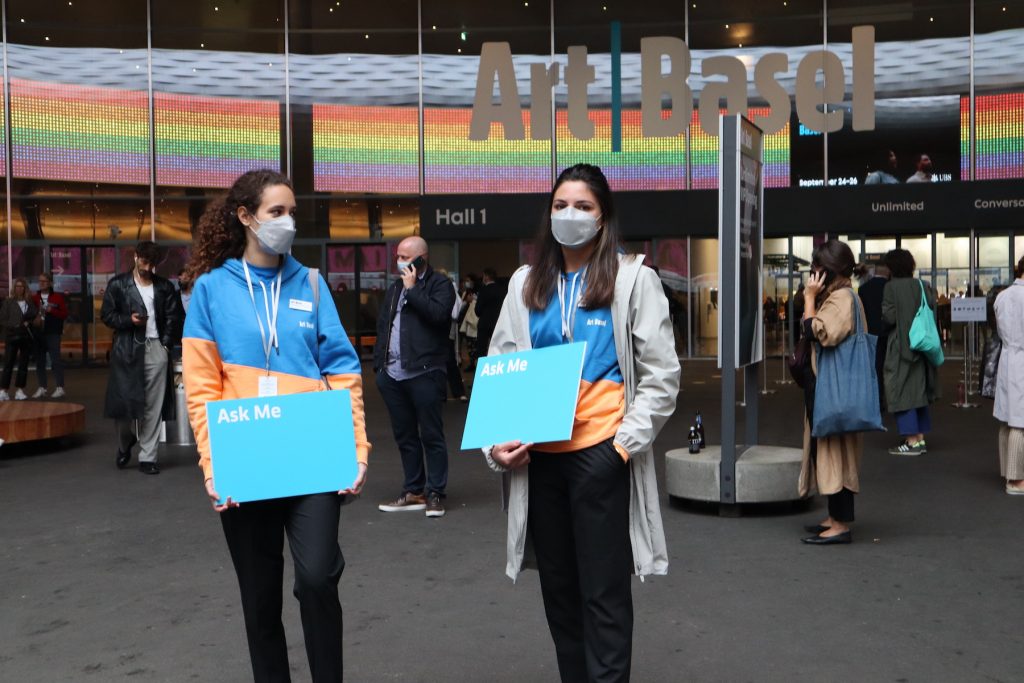
Photo by Naomi Rea.
This year, prominent executives at Art Basel, Frieze, and the Armory Show left in search of greener pastures. The mass exodus reflects growing concerns about the sustainability of the business model while a new online sales boom has shown dealers that there are viable alternatives to gaining new clients.
Some fairs upped their customer service in the face of ongoing uncertainty around the pandemic, offering discounted rates and assurances, a move led by Art Basel with its novel solidarity fund. But in the middle of a second pandemic winter, it made better financial sense for others to pull the plug on their fair altogether and wait for brighter days, as TEFAF Maastricht did in mid-December, calling off its 2022 edition.
Is the writing on the wall for art fairs? Where some of these executives head next might be a good indicator as to which sector of the market will thrive. Noah Horowitz, Art Basel’s former director of Americas who departed for a gallery whisperer role at Sotheby’s, for one, seems to be betting on auction-house efforts to power up their private sales arms, a trend that accelerated during the pandemic.
Should Hunter Biden Really Be Selling His Art?
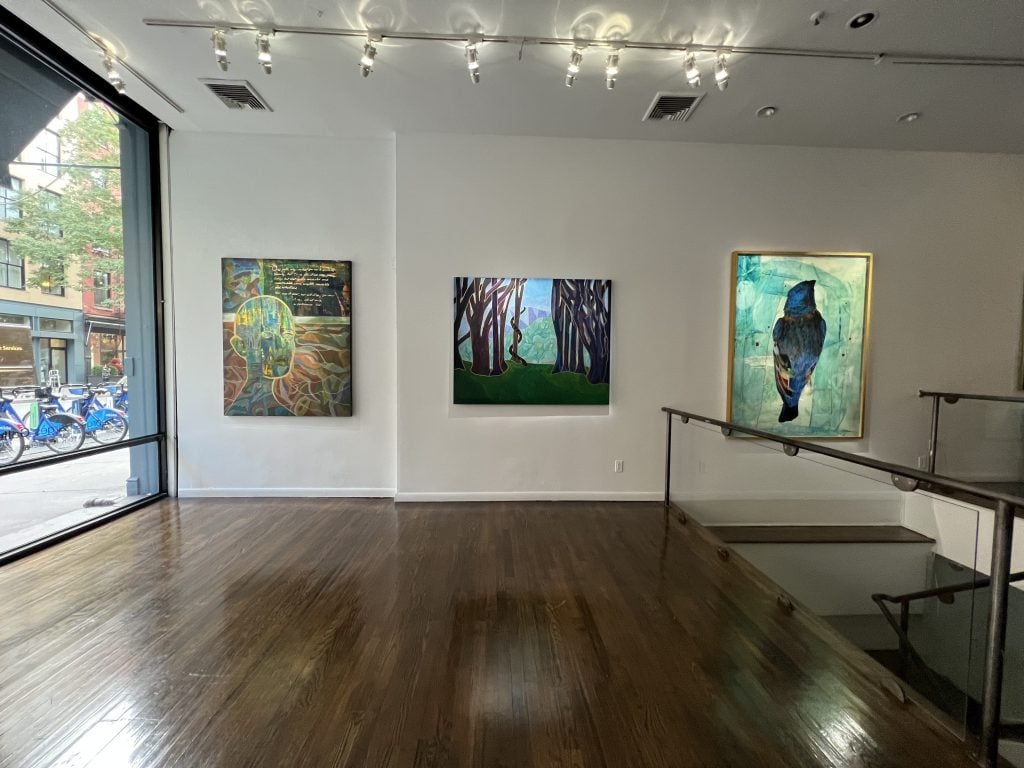
Installation view “Hunter Biden: The Journey Home” at Georges Bergès Gallery. Photo: Katya Kazakina.
Hunter Biden’s New York gallery debut was one of the most controversial art exhibitions in recent memory. After U.S. president Joe Biden’s son left the world of lobbying to embrace a career as an artist, concerns mounted that political influence peddlers may try to use the First Son to court favors with the White House—especially after it emerged that the price range for works was a lofty $75,000 for drawings and $500,000 for paintings.
In an effort to assuage concerns, Biden’s New York gallerist Georges Bergès struck a bizarre ethics agreement with the White House to keep Biden’s sales information confidential from the government and also the artist, including prices and the identities of buyers and interested parties. The curious deal also included a promise from Bergès to reject any offer he deems suspect or that comes in over the asking price. It was not enough to cool opposition: Florida Congressman Mike Waltz introduced the Painter Act, which would require current and future presidents to disclose their adult children’s finances.
Is The Era of the Art World Scammer Coming To An End?
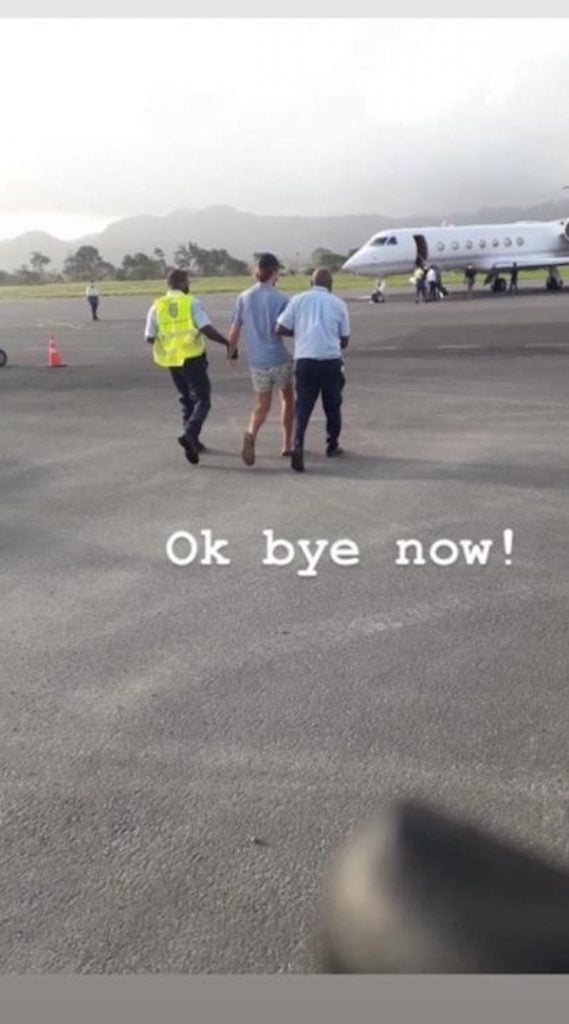
A post to a private Instagram account in June 2020 shows Inigo Philbrick in zip-ties being escorted to a Gulf-stream jet in Vanuatu.
All industries have their share of bad apples, but the art world has its own unique basket of notorious characters whose wrongdoings are inextricably linked with the wooly nature of the art trade. Angela Gulbenkian, the German socialite and purveyor of a $1.4 million Yayoi Kusama pumpkin sculpture that she had no rights to and (obviously) never delivered to her hapless buyer was sentenced to three and a half years in prison. Authorities closed in on another alleged scammer, artist Christian Rosa, who was indicted on charges of selling fake Raymond Pettibon paintings. He was arrested in Portugal in December.
Notorious swindler Inigo Philbrick, who was captured in the South Pacific in 2020, pleaded not guilty to the US government’s charges of wire fraud and aggravated identity theft. But more than a year and a half in federal prison seems to have given the art dealing con man time for reflection: Last month, he pleaded guilty to a criminal charge of wire fraud. He faces up to 20 years in prison when he is sentenced in March 2022. Philbrick also agreed to turn over to authorities some $86.7 million that is said to be traceable to the fraud, and to forfeit paintings by Christopher Wool and Wade Guyton, among others. He will also make restitution to his victims in an amount yet to be determined by the judge.
Should Museums Enforce Vaccine Passes?
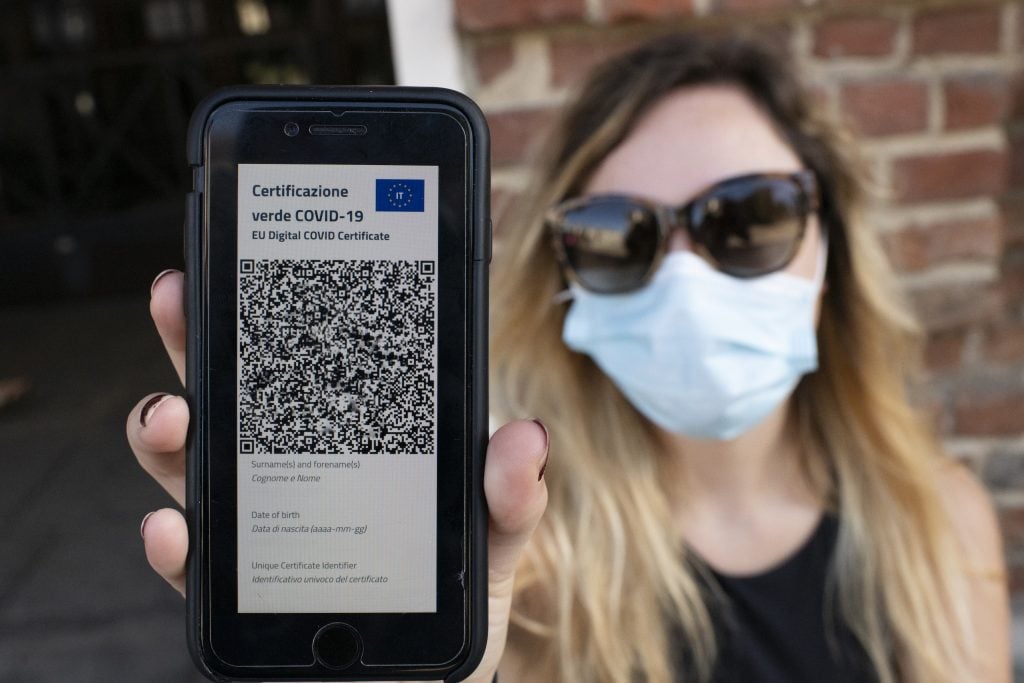
A woman shows Italy’s COVID-19 Green Pass for post-vaccine travel on a smartphone on June 30, 2021 in Turin, Italy. Photo by Stefano Guidi/Getty Images.
Protests erupted in France and Italy over their respective versions of vaccine passes, and some New Yorkers were similarly angered over the “Key to NYC” pass, all of which required visitors to show digital certificates proving vaccination or a negative test result before accessing public services including museums. At least one museum director, Fabrizio Masucci, longtime director of the Sansevero Chapel Museum in Naples, resigned from his post in protest of the rules in Italy.
While the mandates in each case have come as part of broader government policies, some have questioned whether it is right to bar access to museums—the U.K.’s national museum directors council argued that such passes are “at odds with the public mission and values of museums.” Some think it is an inappropriate form of exclusion and discrimination. At least one study shows museums to be lower-risk than grocery stores when there are safety restrictions in place such as mask-wearing and social distancing measures.
How Should Art Institutions Deal With Objects From the Colonial Era?
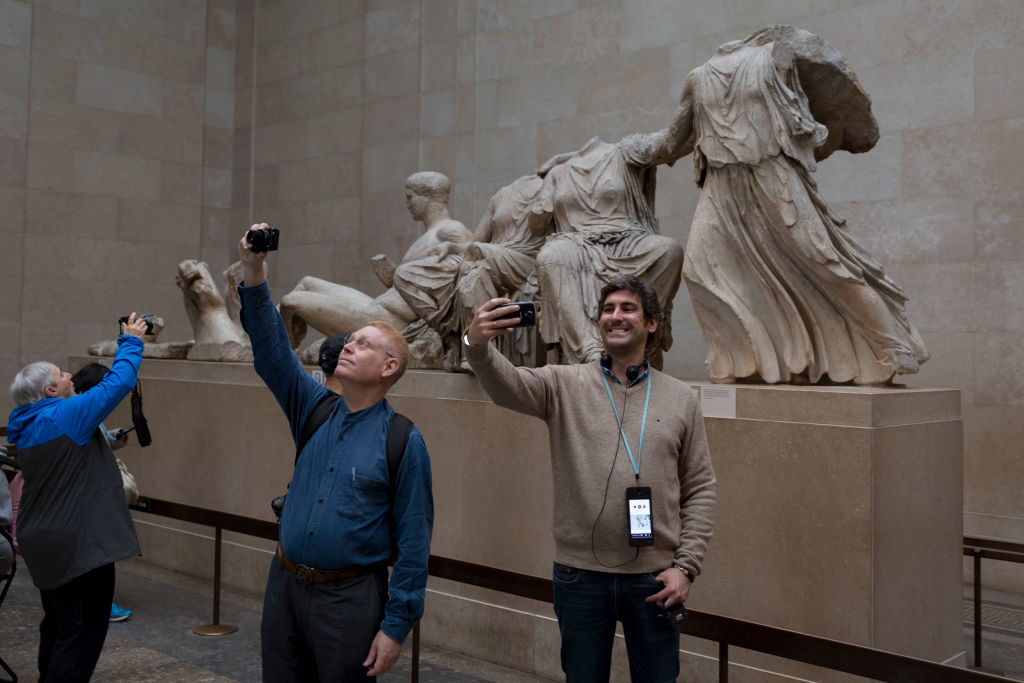
Visitors pose in front of the British Museum’s Elgin Marbles that originate from the Parthenon in Athens. Photo by Richard Baker / In Pictures via Getty Images.
More countries and institutions in the West have been actively taking the initiative to repatriate stolen artworks and artifacts to the rightful owners. The Benin bronzes—looted by British soldiers in a punitive expedition in 1897—have been in the spotlight as a number of notable milestones took place this year. Germany agreed to begin sending the Benin bronzes back to Nigeria in 2022. The Musée du Quai Branly in Paris also returned 26 of them. Cambridge and Aberdeen universities are also among the first in the U.K. to send the treasured bronzes back home.
Restitution of Nazi-looted art has also made good progress, such as the case for the Bavarian State Painting Collections in Munich, which handed over a work to the heirs of Jewish dealer A.S. Drey. The Philadelphia Museum of Art also returned a work to the Czech Republic. Washington’s National Gallery of Art and the Kunstmuseum Bern in Switzerland also followed suit this year.
But one of the biggest debates is the U.K.’s reluctance to move forward in discussions with Greece and address its restitution claims of the Parthenon Marbles, which are currently housed in the British Museum. Calls were raised at a UNESCO meeting this fall, and even the Greek leader Kyriakos Mitsotakis brought up the issue in-person with U.K. prime minister Boris Johnson. Will the U.K. and the British Museum change their mind next year amid the growing pressure? Oxford professor Dan Hicks expects the tide to change by 2030.
Is There a Future for the Art World in Hong Kong?
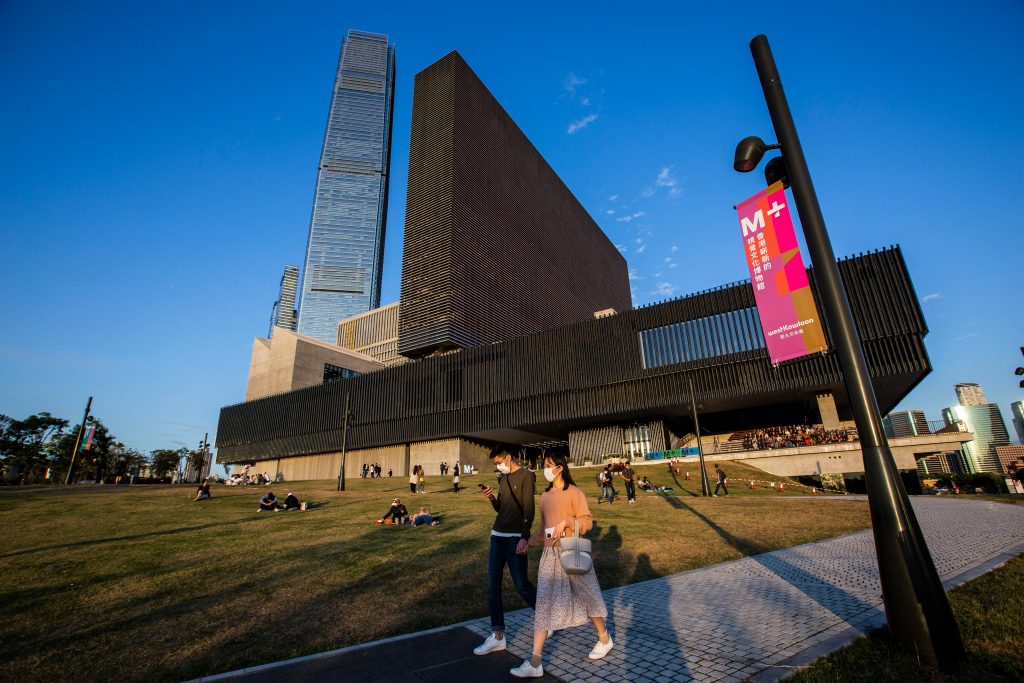
The new M+ Museum is seen in Hong Kong on November 11, 2021. (Photo by ISAAC LAWRENCE / AFP) (Photo by ISAAC LAWRENCE/AFP via Getty Images)
It has been a big year for Hong Kong: the long-awaited M+ museum has finally opened and art auctions there have gone through the roof as the art world has been increasingly looking eastwards. But beneath these developments is ongoing concerns about the future of Hong Kong. The implementation of the national security law in 2020 has cast a shadow over the creative freedom that the former British colony has long enjoyed. Censorship of a work by Ai Weiwei at M+ left many questioning if artists and culture professionals can still work freely at all. A threat to take down an iconic sculpture called Pillar of Shame at the University of Hong Kong also raised concern about the city’s tolerance of freedom of expression.
Meanwhile, stringent travel restrictions of up to three weeks in mandatory quarantine have been keeping the international art world out of Hong Kong. For two years in a row, Art Basel could only stage a regionally focused edition with primarily local buyers. Given the uncertainty, the international art world has already started exploring other potential spots in Asia. Seoul in South Korea has become a hotspot, with a number of global galleries setting up new shops there and the inaugural edition of Frieze Seoul is expected to take place in 2022. Could this be a new era for the art world in Asia?
Will Museums Continue to Divest of Problematic Sources of Money?
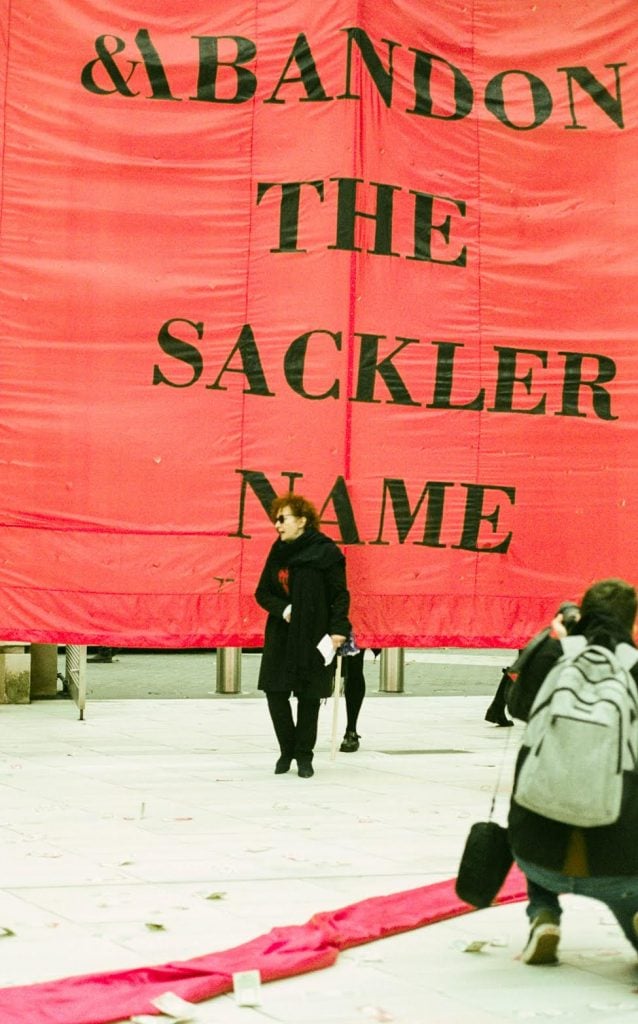
Nan Goldin protesting with Sackler P.A.I.N. at the Victoria and Albert Museum in London in 2019. Photo by Lottie Maher, courtesy of Sackler P.A.I.N.
Several years’ worth of damning revelations about the role that the Sackler family, via its Purdue Pharma corporation, played in the opioid crisis led to increasing pressure on cultural institutions to remove the Sackler name.
Finally, in mid-December, the Met in NYC removed the Sackler name from seven spaces in its galleries, a move that could be seen as either overdue capitulation or a reflection of one of the most significant victories for activists seeking to hold the family accountable.
It also emerged that artist Nan Goldin, who has been at the center of those efforts since 2018 when she founded the organization Sackler P.A.I.N., had enlisted a powerful group of artists to help her put pressure on institutions—Ai Weiwei, Anish Kapoor, Barbara Kruger, Richard Serra, and Kara Walker joined the cause.
As part of a $4.5 billion Oxycontin settlement outlined this summer, the Sackler family promised not to lend its name to museums for nine years. Even then, critics said it didn’t go far enough. The standoff between the deep-pocketed family and activists, victims, and individual states in the US is far from over. On December 17, a federal judge ruled that a negotiated settlement between Purdue Pharma and thousands of state, local, and tribal governments that had sued it, should not move forward because it released the Sackler family members from liability.
Is There a Major Recalibration Coming for Mega-Galleries?
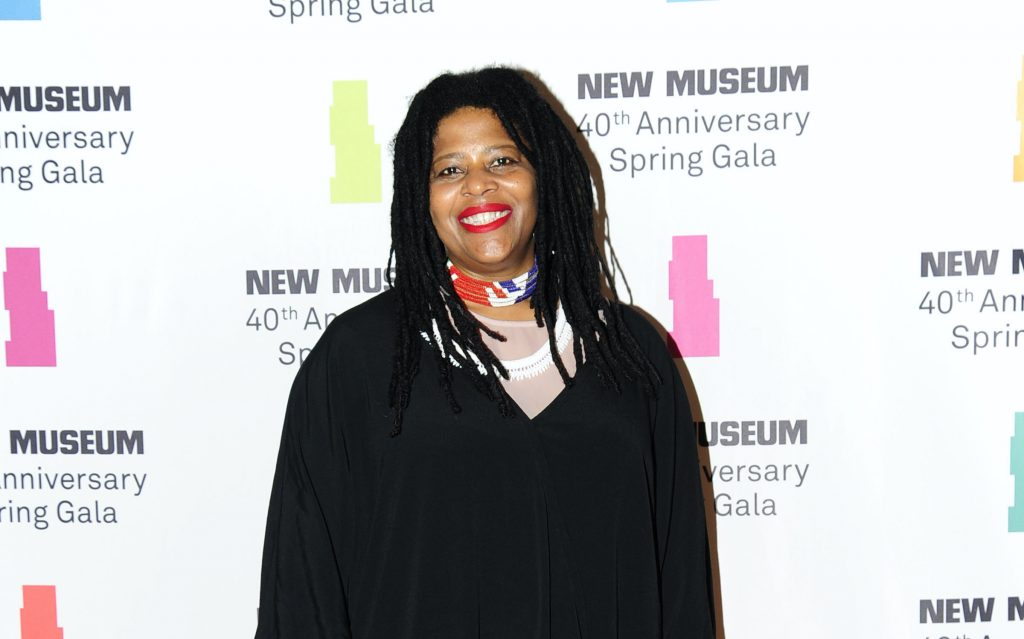
Simone Leigh. Photo by Paul Bruinooge, ©Patrick McMullan.
News that celebrated sculptor Simone Leigh was splitting with mega-gallery Hauser & Wirth set the art world gossip circuit alight in early November. Questions swirled about where Leigh would land after after less than two years and ahead of her participation in the Venice Biennial. In a statement, Leigh said that while she loves and respects the people she worked with at Hauser, “I do not feel the gallery is the right fit for me in the wider sense. I’m still figuring out what I want from a primary gallery relationship.”
A few weeks later as the masses descended on Art Basel Miami Beach for the VIP opening day, Artnet News revealed that she jumped ship to a revered non-mega dealer, Matthew Marks.
Is it possible that the mega dealers like David Zwirner and Gagosian are no longer the end-all be-all for at least some art stars?
Earlier this year, art star Jeff Koons—who is infamous for being difficult to buy and whose market has seen better days—left both Gagosian and David Zwirner in favour of Pace. While Pace is a mega-gallery in its own right, It’s a family-run operation. A few experts we talked to pointed that this quality harkened back to Koons’ glory days in the 1980s with dealer Ileana Sonnabend, who worked with her adopted son Antonio Homem.
Pace has also struggled at times with the challenges of operating a mega-gallery. A detailed report in Artnet News last year looked at how an abusive work environment at the so-called art business of the future was actually keeping it stuck in the past.
How Will Institutions and Galleries Truly Reform?
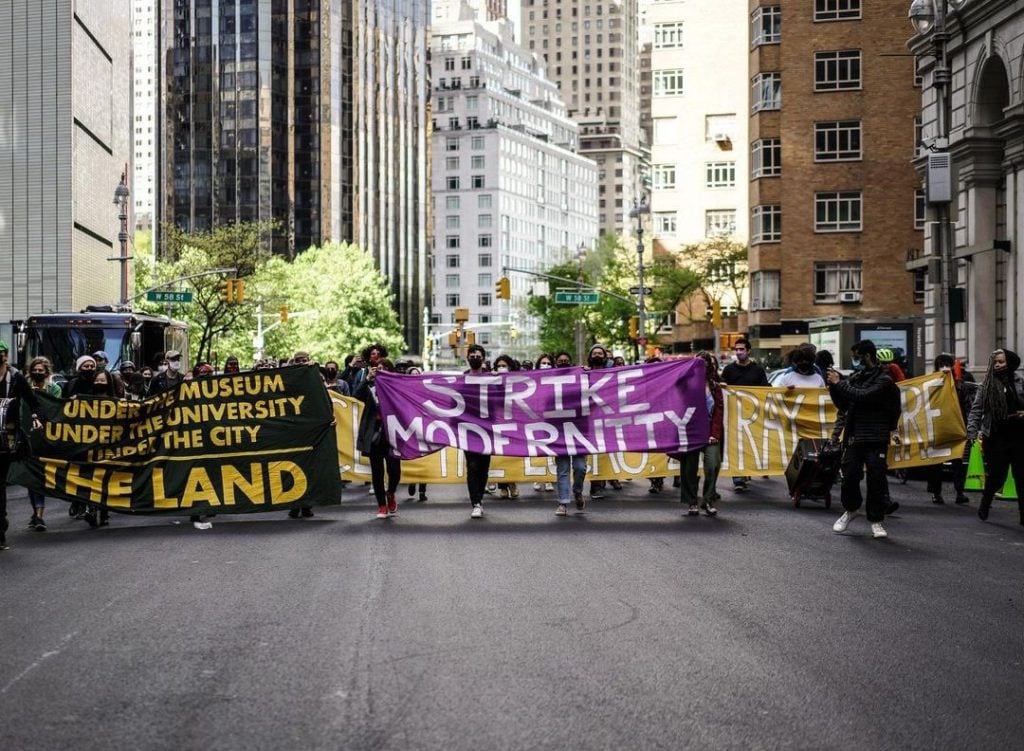
Strike MoMA demonstrators marching through midtown New York. Courtesy of Decolonize This Place via Twitter.
Cultural institutions are facing unprecedented challenges in a politically-charged era. Protests against mismanagement, structural racism and labor issues such as pandemic-related layoffs have placed institutions under the microscope throughout the year, and many museums are facing a problem of brain drain. A number of vacancies at museums in the U.S. signifies a transition of leadership but also a widening gap in art management as museum director is no longer such an appealing job. It’s “emotionally unsustainable” and “a challenge to navigate the wealth gap between low-paid staff and wealthy trustees,” said museum executive Laura Raicovich. New York’s Museum of Modern Art faced ten weeks of protest from activists Strike MoMA condemning the “toxic philanthropy” of the museum’s trustees.
Across the Atlantic, London’s Barbican Centre faced serious allegations over its “inherently racist” work culture. The incident prompted Barbican to launch an independent investigation. Artists also called for a defunding of the Centre for Chinese Contemporary Art in Manchester, U.K. which was accused of institutional racism. Artists with plans to show at these galleries have distanced themselves by withdrawing projects with these institutions.
















